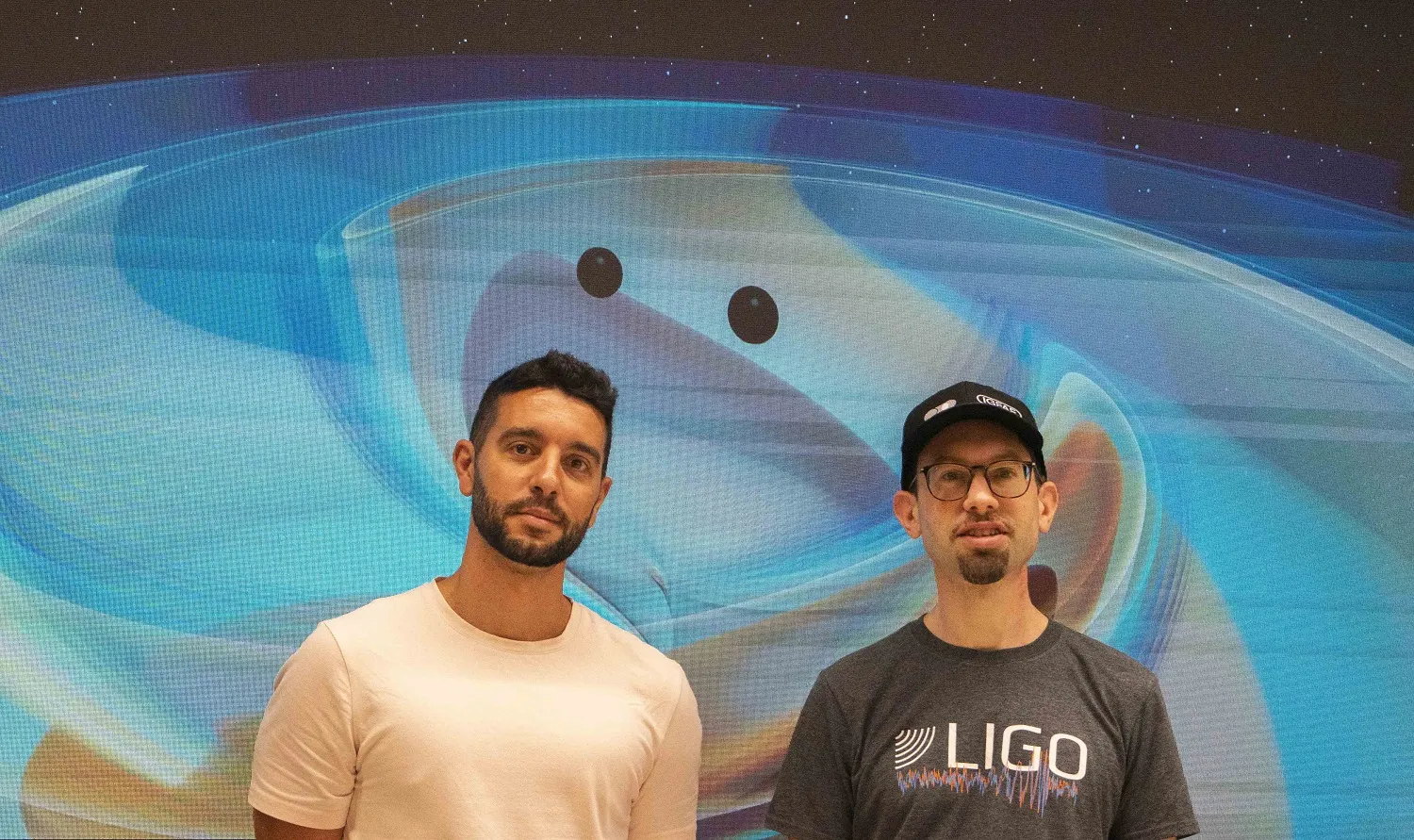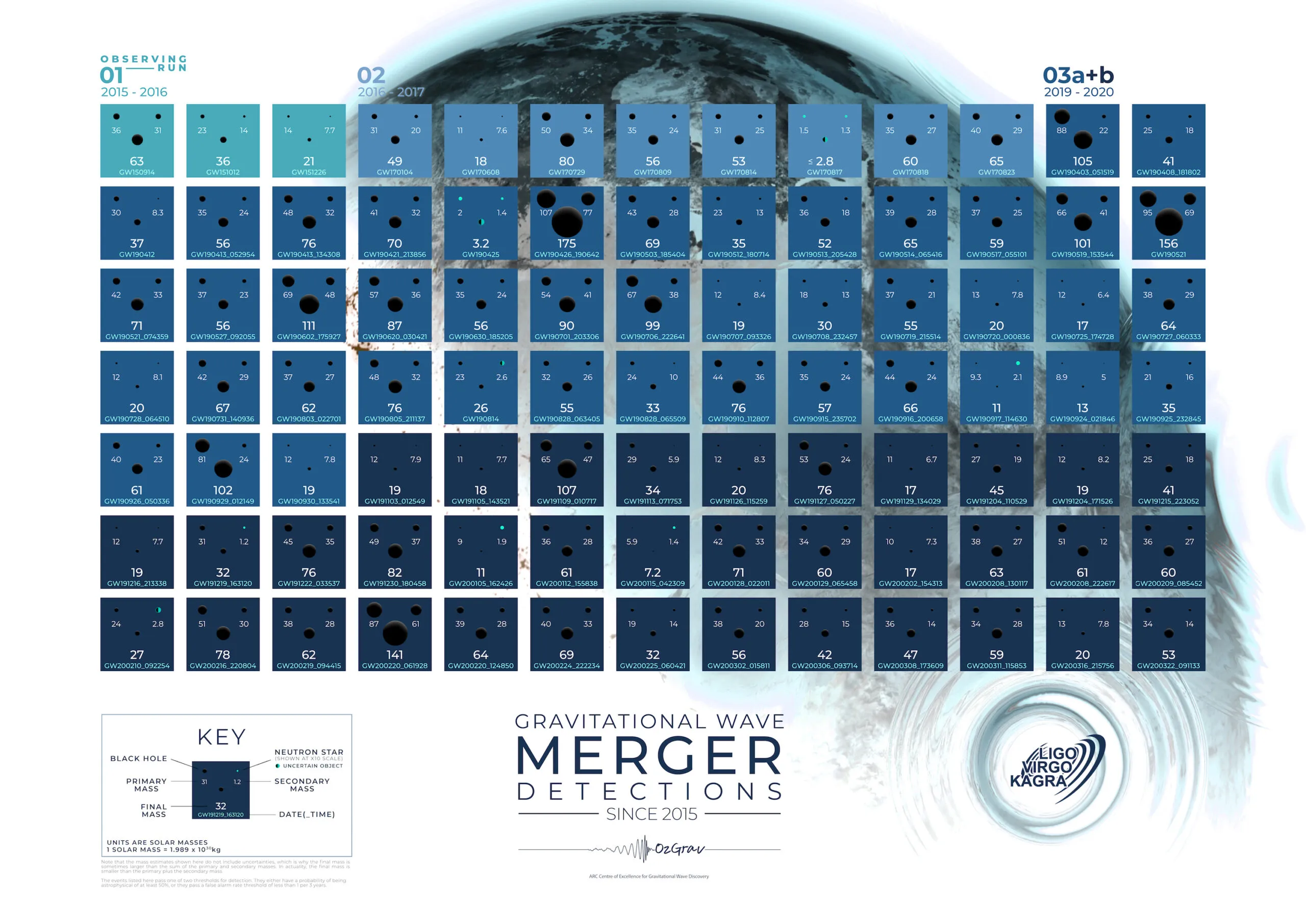Buracos negros chocando no límite da relatividade de Einstein: un achado de récord co protagonismo do IGFAE



08.11.2021

Un esforzo internacional
O catálogo actualiza a lista de todos os eventos de ondas gravitacionais observados ata a data con eventos observados entre novembro de 2019 e marzo de 2020, utilizando tres detectores internacionais: os dous detectores do Observatorio Avanzado de Ondas Gravitacionais por Interferómetro Láser (LIGO) en Luisiana e o estado de Washington nos Estados Unidos, e o detector avanzado Virgo, en Italia. Os datos destes tres detectores foron coidadosamente analizados por un equipo científico da Colaboración Científica LIGO, a Colaboración Virgo e a Colaboración KAGRA.
Que viu LIGO-Virgo-KAGRA?
Dos 35 eventos detectados, 32 eran probablemente fusións de buracos negros, é dicir, dous buracos negros que viran un ao redor do outro e finalmente únense, un evento que emite un refacho de ondas gravitacionais.
Os buracos negros son de distintos tamaños e o máis masivo ten unha masa 90 veces superior á do noso Sol. Varios dos buracos negros resultantes destas fusións superan as 100 veces a masa do noso Sol e clasifícanse como buracos negros de masa intermedia. Este tipo de buraco negro foi teorizado durante moito tempo polos astrofísicos. Estas últimas observacións de LIGO-Virgo- KAGRA confirman que esta nova clase de buracos negros é máis común no universo do que se pensaba.
Dous dos 35 eventos detectados poderían ser estrelas de neutróns e buracos negros que se fusionan, un evento moito máis raro e que só se descubriu na última serie de observacións de LIGO e Virgo.
Destas raras fusións de estrelas de neutróns e buracos negros, un evento parece mostrar un buraco negro masivo (unhas 33 veces a masa do noso Sol) cunha estrela de neutróns de moi baixa masa (unhas 1,17 veces a masa do noso Sol). Trátase dunha das estrelas de neutróns de menor masa xamais detectadas, xa sexa mediante ondas gravitacionais ou observacións electromagnéticas. As masas dos buracos negros e das estrelas de neutróns son pistas crave para saber como viven as estrelas masivas e como morren nas explosións de supernovas.
Juan Calderón Bustillo, investigador “La Caixa Junior Leader” no IGFAE, comenta que “mentres que a primeira ducia de eventos que observamos eran moi similares entre eles, agora estamos a empezar a desentrañar unha importante variedade de fusións de parellas buracos negros: desde fusións moi asimétricas ata outras moi pesadas que dan lugar ao que chamamos buracos negros de masa intermedia. Con todo, fáltanos observar unha gran parte deste misterioso zoo de buracos negros e quen sabe se dalgunha outra sorpresa. Isto requirirá detectores mellorados e algoritmos de procura máis refinados”.
Un dos eventos de ondas gravitacionais do catálogo procedía da fusión de dous obxectos, un dos cales era case con toda seguridade un buraco negro (cunha masa unhas 24 veces a do noso Sol), pero o outro era un buraco negro moi lixeiro ou unha estrela de neutróns moi pesada dunhas 2,8 veces a masa do noso Sol. O máis probable é que se trate dun buraco negro, pero non se está totalmente seguro. Un evento ambiguo similar foi descuberto por LIGO e Virgo en agosto de 2019. A masa do obxecto máis lixeiro é desconcertante, xa que os científicos esperan que o máis masivo que pode ser unha estrela de neutróns antes de colapsar para formar un buraco negro é ao redor de 2,5 veces a masa do noso Sol. Con todo, non se descubriu ningún buraco negro con observacións electromagnéticas con masas inferiores a unhas 5 masas solares. Isto levou aos científicos a teorizar que as estrelas non colapsan para formar buracos negros neste rango. As novas observacións de ondas gravitacionais indican que estas teorías poderían ter que ser revisadas.
Un progreso monumental
As ondas gravitacionais foron preditas por primeira vez por Albert Einstein a partir da súa teoría da relatividade xeral en 1916. Como as ondas gravitacionais que chegan á Terra son tan minúsculas, necesitáronse moitas décadas de traballo para construír instrumentos o suficientemente precisos para medilas.
Desde a primeira detección de ondas gravitacionais en 2015, o número de deteccións aumentou a un ritmo vertixinoso. En cuestión de anos, pasouse de observar estas vibracións no tecido do universo por primeira vez a observar agora moitos eventos cada mes, e mesmo múltiples eventos no mesmo día.
Os detectores de ondas gravitacionais funcionan utilizando láseres de alta potencia para medir coidadosamente o tempo que tarda a luz en viaxar entre os espellos ao longo de dous brazos perpendiculares. No terceiro ciclo de observación, os detectores de ondas gravitacionais alcanzaron o mellor rendemento da súa historia. Para lograr este monumental progreso, os instrumentos pioneiros han ido aumentando a súa sensibilidade grazas a un programa de actualizacións e mantemento constantes.
Os detectores LIGO e Virgo seguen mellorando, por exemplo, co aumento da potencia do láser e a instalación de luz comprimida. As excelentes sensibilidades dos detectores permitiron a observación de moitos máis eventos de ondas gravitacionais emocionantes, incluíndo a primeira detección binaria segura de estrela de neutróns-buraco negro. Os detectores LIGO e Virgo seguen mellorando, por exemplo, co aumento da potencia do láser e a instalación de luz comprimida. As excelentes sensibilidades dos detectores permitiron a observación de moitos máis eventos de ondas gravitacionais emocionantes, incluíndo a primeira detección binaria segura de estrela de neutróns-buraco negro.
O uso da luz comprimida implica aproveitar as propiedades mecánicas cuánticas da luz para minimizar as incertezas nas medicións. A mecánica cuántica limita a precisión coa que se poden medir a posición e o momento de algo. A luz comprimida é un estado mecánico cuántico especial da luz que minimiza a incerteza nas propiedades necesarias para as medicións das ondas gravitacionais.
Ollos no ceo
A medida que aumenta o ritmo das deteccións de ondas gravitacionais, os científicos tamén melloraron as súas técnicas de análises para garantir a gran precisión dos resultados. O crecente catálogo de observacións permitirá estudar as propiedades dos buracos negros e as estrelas de neutróns cunha precisión sen precedentes.
Thomas Dent, coordinador do programa de investigación sobre ondas gravitacionais do IGFAE, afirma: “Estas recentes deteccións, que inclúen un novo tipo de binaria compacta, son de gran interese astronómico en si mesmas. Ademais, cantas máis fontes de ondas gravitacionais detectemos, mellor poderemos aproveitalas para investigar enigmas científicos máis amplos. Estas cuestións inclúen a taxa de expansión do Universo, a física dos estalidos de raios gamma e como se formaron e evolucionaron os buracos negros e as estrelas de neutróns ao longo da historia cósmica, todo iso abordado en artigos que aparecen simultaneamente co novo catálogo”.
A identificación de sinais nos datos dos detectores require unha coidadosa análise para distinguir as ondas gravitacionais reais do ruído. Utilizando a información da rede internacional de detectores recompilada durante o período de observación, o equipo puido deducir coidadosamente que deteccións eran realmente interesantes.
Noutro avance significativo desta recente carreira, aos poucos minutos das deteccións iniciais, os astrónomos fixeron un chamamento público a outros observatorios e detectores de todo o mundo. Esta rede de detectores de neutrinos e observatorios electromagnéticos centrouse na zona da que procedían as ondas, para tratar de identificar o evento fonte. Estes sinais electromagnéticos e de neutrinos son raras e moi difíciles de atopar. Poder buscar rapidamente é unha gran vantaxe. Ningunha das ondas gravitacionais anunciadas recentemente ten unha contrapartida.
O futuro do campo
Os observatorios LIGO e Virgo están a ser mellorados antes da cuarta rolda de observación, que se espera que comece na segunda metade do próximo ano.
O observatorio KAGRA, en Xapón, tamén se unirá á próxima rolda de observación completa. Situado nas profundidades dunha montaña, KAGRA completou con éxito o seu primeiro ciclo de observación en 2020, pero aínda non se uniu a LIGO e Virgo para realizar observacións conxuntas. Con máis detectores, os posibles eventos poden localizarse con maior precisión.
A medida que se engaden máis deteccións ao catálogo de ondas gravitacionais, os investigadores aprenden cada vez máis sobre estes fenómenos astronómicos.
Antes da próxima rolda de observación, os científicos estarán ocupados analizando a información existente, aprendendo máis sobre as estrelas de neutróns e os buracos negros, e buscando novos tipos de sinais ocultos nos datos.
Información adicional sobre os observatorios de ondas gravitacionais
Seis grupos españois contribúen ao estudo e análise das ondas gravitatorias detectadas por LIGO-Virgo- KAGRA, en áreas que van desde o modelado teórico das fontes astrofísicas e a análise dos datos ata a mellora da sensibilidade dos detectores para os períodos de observación actuais e futuros. Dous grupos, na Universitat de les Illes Balears (UIB) e o Instituto Galego de Física de Altas Enerxías (IGFAE), centro mixto da Universidade de Santiago de Compostela (USC) e a Xunta de Galicia, forman parte da Colaboración Científica LIGO; mentres que a Universitat de València (UV), o Instituto de Ciencias del Cosmos da Universidad de Barcelona (ICCUB), o Institut de Física d’ Altes Energies (IFAE) de Barcelona e o Instituto de Física Teórica (IFT) da Universidade Autónoma de Madrid-CSIC son membros de Virgo.
A contribución española está financiada pola Axencia Estatal de Investigación, Ministerio de Ciencia, Innovación e Universidades, a través dos programas AYA e FPN, programas de Excelencia Severo Ochoa e María de Maeztu, programas de financiamento da Unión Europea, Fondos FEDER, Fondo Social Europeo, a Consellería de Fondos Europeos, Universidade e Cultura e a Dirección Xeral de Política Universitaria e Investigación do Goberno das Illas Baleares, Conselleria d’ Innovació, Universitats, Ciència i Societat Dixital da Generalitat Valenciana, programa Preto da Generalitat de Catalunya, a Consellería de Cultura, Educación e Universidade da Xunta de Galicia, e teñen o apoio da Rede Española de Supercomputación (RES).
Referencias:
GWTC-3: Compact Binary Coalescences Observed by LIGO and Virgo During the Second Part of the Third Observing Run [pdf download from LIGO DCC] [arXiv version].
Constraints on the cosmic expansion history from the third LIGO-Virgo-KAGRA Gravitational-Wave Transient Catalog [pdf download from LIGO DCC] [arXiv version]
Search for Gravitational Waves Associated with Gamma-Ray Bursts detected by Fermi and Swift during the O3b LIGO-Virgo Run [pdf download from LIGO DCC] [arXiv version]
The population of merging compact binaries inferred using gravitational waves through GWTC-3 [pdf download from LIGO DCC] [arXiv version]
Imaxe: Táboa gráfica de todos os eventos de ondas gravitacionais descubertos desde 2015 ata o final do terceiro ciclo de observación de LIGO/Virgo. A táboa inclúe o nome do evento gravitacional, o tipo de compoñente binario (buraco negro, estrela de neutróns ou incerto), as masas do primario e do secundario, e a masa do obxecto final fusionado. Véxase tamén unha versión de gran tamaño do arquivo (19 MB) adecuada para a impresión de carteis, así como unha versión con fondo negro. Crédito: LIGO/Virgo/ KAGRA/ C. Knox/ H. Middleton.